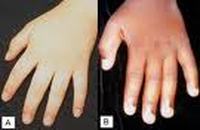What is Aicardi-Goutieres Syndrome?
This syndrome is a disorder that mainly affects the brain, immune system, and skin. It mostly affects new borns but doctors can not tell because the symptoms and signs do not show, well at first. 20 percent of new borns are born with a enlarged liver and spleen that then effects the level of blood in the enzymes, therefore causes abnormal responses. With all these symptoms is usually associted with the immune systems congenital viral infection ,but no actual infection is found in these infants. For these reasons Aicardi-Goutieres syndrome is also called, "mimic of congenital infection." Within the first year, most Aicradi-Goutieres Syndrome experience an episode of severve brain dysfunctions, usually lasting for many months. During this phase of the disorder, affected babies are usually extremely irritable and do not eat well or completely. They may develop fevers when there there are no infections and have seizures. They stop developing new skills and begin losing skills they had already gotten. Growth of the brain and skull slows down, therefore an abnormally small head size. About 40 percent of people with Aicardi-Goutieres syndrome have painful, itchy skin lesions, mostly on their fingers, toes, and ears. These puffy, red lesions, which are called chilblains, are caused by inflammation of small blood vessels. They appear worse by exposure to cold. Vision problems, joint stiffness, and mouth ulcers may also show up in this disorder. Any Treatments? There is no cure for Aicardi-Goutieres syndrome. However, its symptoms can be managed so the child is more comfortable and the symptoms can be slowed down. Realizing the problems and treating them before they become severe should be a priority in treating patients with Aicardi-Goutieres syndrome.
It can be inherited by the genes is an autosomal recessive pattern, which means both copies of the gene in each cell have mutations. Both paret usualy carry the gene but it is not noticable that they both carry the mutated gene. Its rare when this condition is inherited in an autosomal dominant pattern, which also means that one copy of the altered or changed in a way gene in each cell is enough to cause the disorder. The result is a new mutation in the gene and only occurs to people with no past history of the disorder in their generation or family.
Genes related to Aicardi-Goutieres Syndrome- mutations in the TREXI, RNASEH2A, RNASEH2B, RNASEH3C, AND SAMHDI genes that have been identified in people with Aicardi-Goutieres Syndrome. The REXI, RNASEH2B, and RNASEH2C genes provide instructions for making the nucleas, which is enzymes that help break up into DNA and a relative called RNA. These result in mutations and disfunctional nuclease enzymes. This will mess up the geneitc replication and so forth, which can cause skin abnormalities.
Informational Video: http://www.youtube.com/watch?v=NcRWyYNhhhk.
It can be inherited by the genes is an autosomal recessive pattern, which means both copies of the gene in each cell have mutations. Both paret usualy carry the gene but it is not noticable that they both carry the mutated gene. Its rare when this condition is inherited in an autosomal dominant pattern, which also means that one copy of the altered or changed in a way gene in each cell is enough to cause the disorder. The result is a new mutation in the gene and only occurs to people with no past history of the disorder in their generation or family.
Genes related to Aicardi-Goutieres Syndrome- mutations in the TREXI, RNASEH2A, RNASEH2B, RNASEH3C, AND SAMHDI genes that have been identified in people with Aicardi-Goutieres Syndrome. The REXI, RNASEH2B, and RNASEH2C genes provide instructions for making the nucleas, which is enzymes that help break up into DNA and a relative called RNA. These result in mutations and disfunctional nuclease enzymes. This will mess up the geneitc replication and so forth, which can cause skin abnormalities.
Informational Video: http://www.youtube.com/watch?v=NcRWyYNhhhk.
Skin Mutation From Aicardi-Goutieres Sydrome

With treatment.
The skin mutations on this males foot represent a symptom of Aicardi-Goutieres Syndrome.
Since SAMHD1 gives instructions to make the protien but with the disorder the body functions that make the protien do not quiet understand so thats how people have the skin mutations.
Since SAMHD1 gives instructions to make the protien but with the disorder the body functions that make the protien do not quiet understand so thats how people have the skin mutations.
Help For Treatments
You also might find information here:
